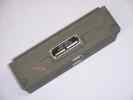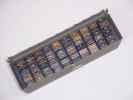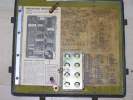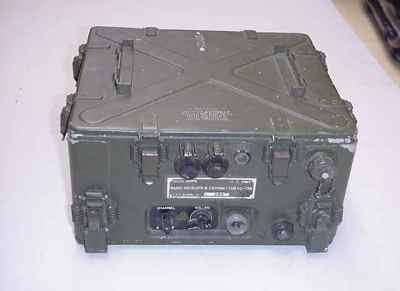History:
SCR-619/BC-1335 (2 Channels, 27 .. 38.9 MHz)
was developed to replace the not so successful
SCR-610/BC-659 (2 Channels, 27 .. 38.9 MHz)
Some of the reasons were: At the start of WW II there were only few crystal manufacturers; of course there was a shortage
since millions of crystals wer needed. There was evidently an effort to boost production, and that succeeded.
There was also an effort to reduce the number of crystals used in radios. The BC-659 used 4 crystals per set,
2 for Tx and 2 for Rx. The BC-1335 used 2 crystals for the two Rx-channels, and a reactance modulator to keep the Tx on
frequency, as did the PRC-6 in later years. Of course, the Rx has to run in Tx mode, but it uses half the crystals.
Besides, BC-659 had a built-in "bias battery", providing several positive and negative voltages,
without them RX and TX will not work properly.
The high crystal consumption and the difficulties with the Bias Battery lead to the replacement of the
BC-659 by the BC-1335.
The advantages of the BC-1335 compared to the BC-659 were:
1335 offers better reliability
less crystal usage
more modern design
more versatility
 |
 |
CS-137
Crystal box for BC-1335
(120 crystals)
crystal # 270..389 |
The BC-1000 was the basis to develop the BC-1335.
A comparison BC-1000 / BC1335 can be found:
Here:
 Optical comparison between BC-1000 und BC-1335 Optical comparison between BC-1000 und BC-1335
Usage:
SCR-619/BC-1335
(as part of Radio Set SCR-619) is a WW II FM mobile radio, built by DELCO. The power supply is built in,
6 or 12 V are selected on the front plate. The antenna foot is attached directly to the back of the radio.
It was used by a number of parts of the Army.
BC-1335 together with battery box CY-740/PRC mounted on a "packboard" was the portable
station. (See picture gallery).
This use, however, was of secondary meaning.
On the inside of the upper cover you can find:
presetting instructions, schematics and a small compartment for additional crystals.
 |
<== Click |
- Frequency range:
- 27 ... 38.9 MHz

Technical data:
- Channels:
- 2, crystal controlled, of 120 possible
- Frequency departure:
- 100 KHz
- Modulation:
- FM
- HF Output:
- 1 W
- Tubes:
- 17
- Year of issue:
- 1943 / 44
|




